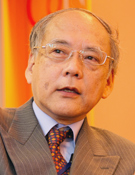
On Friday, March 11, 2011, Japan experienced an enormous magnitude 9.0 ocean-trench earthquake. Many people lost their lives in this tragedy, and I would like to express my heartfelt condolences and regrets to their families. I would also like to send my strong wishes for a quick recovery to those who were injured in the disaster.
These events have reinforced for me the importance of crisis management. The basic principle in crisis management is to consider as many options as possible and to ask leaders to choose the optimal solution among them. During the earthquake, local governments and numerous other organizations responded to the earthquake in strict accordance with the manuals that they had prepared. Even the electric power company had trained for an accident. They offered schools to house refugees, sent in the Self-Defense Forces, and quickly sought the cooperation of the US military. They were able to shut down the nuclear reactor, but the tsunami knocked out the emergency power, which is what led to the crisis. Water continues to be poured on the spent nuclear fuel in an effort to cool it down. We can only bow our heads at the heroism of the employees of the electric power company and other affiliated companies, the firefighters and the Self-Defense Forces who continue to risk their lives to avert the worst outcome.
It was just last August that we visited the Tokyo Electric Power's Kashiwazaki-Kariwa Nuclear Power Plant and toured a containment vessel. We learned about the mechanisms behind the "three principles" for preventing disaster at nuclear reactors: stop, cool, contain. We saw the spent nuclear fuels stored high in the nuclear reactor housing. If nothing else, the accident serves as a warning that we can no longer procrastinate about the final disposal of the spent nuclear fuel nor continue to use as much electric power as we wish to as a society.
The determination of scope is the essence of the act of design. Systems that impinge on human life must be designed with high safety margins, and what was not foreseen in this case was the 9.0 magnitude of the earthquake. Still, the nuclear reactors were shut down, exactly as designed.
If we consider that the Pangaea supercontinent started separating and drifting 200 million years ago and that an ocean trench earthquake of this size occurs once every 500 years when continental plates shift, the Earth has experienced at least 400,000 such quakes in the past. Were we able to perform a Fourier analysis of this event, we would surely find a clear peak for this cycle. Human history is roughly 5 million years old, and the history of Japan, a mere 2,000 years. The annals of science have recorded several earthquakes on par with the great earthquake that hit Tohoku. Nature does not lie. Human beings need to show greater humility. This experience has taught us that we must live in harmony with the system we call "nature."
As I prepare to leave my post on the full-time faculty of the SDM, I would like to express my thanks to the many companies, organizations, and individuals who have provided such generous support to SDM and SDM Research Institute.
Taketoshi Hibiya
Professor, Graduate School of SDM
(Written on March 22, 2011)
